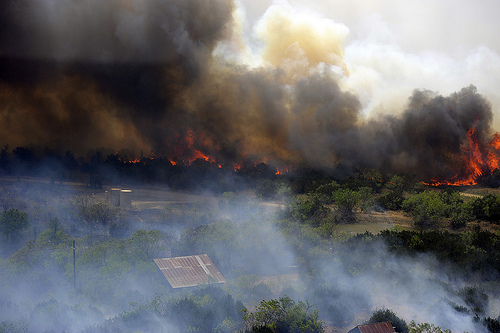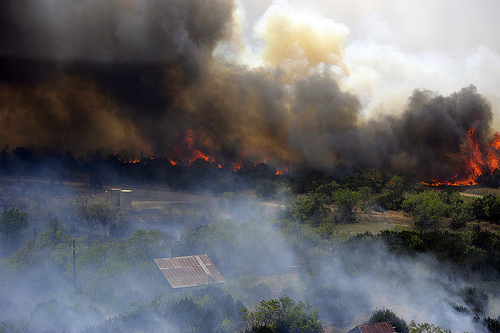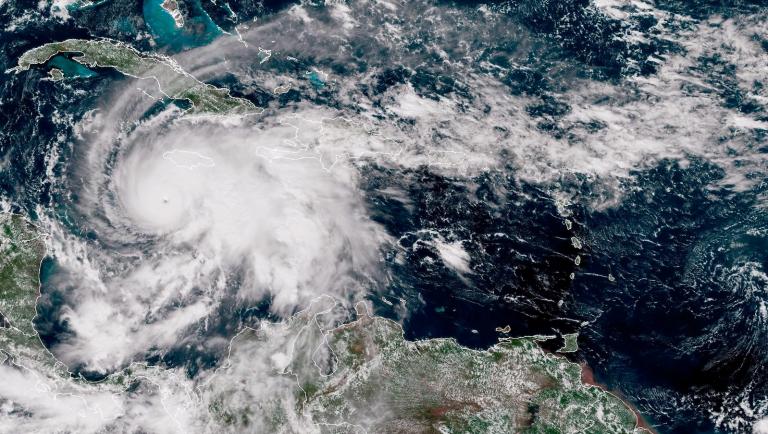 A wildfire burns out of control in Texas earlier this month.Photo: Texas Military ForcesCross-posted from the Center for American Progress. This post was coauthored by Valeri Vasquez, special assistant for energy policy at the Center for American Progress, and Ben Kaldunski, a former intern with the Energy Team at American Progress.
A wildfire burns out of control in Texas earlier this month.Photo: Texas Military ForcesCross-posted from the Center for American Progress. This post was coauthored by Valeri Vasquez, special assistant for energy policy at the Center for American Progress, and Ben Kaldunski, a former intern with the Energy Team at American Progress.
“April is the cruelest month.” – T. S. Eliot
Secure · Tax deductible · Takes 45 SecondsSecure · Tax deductible · Takes 45 Seconds
April 2011 has been a cruel month indeed for Americans due to extreme weather. The Weather Channel observed that:
It’s been a truly awful, record-setting, tornadic April. We’ve had eleven major severe weather events, some lasting multiple days.
These extreme events included supercell thunderstorms in Iowa, severe drought and record wildfires in Texas, and heavy rains across the United States. The recent Southeastern storms and tornados took at least 297 lives across eight states. And heavy rains in the Mississippi River valley could cause the most severe, damaging floods there in nearly a century.
This extreme weather, though record setting in some places, may be the new normal. Last year, unprecedented extreme weather led to a record number of disaster declarations by the Federal Emergency Management Agency. The United States and the world were swept by flooding, severe winter storms, heat waves, droughts, hurricanes, and tornadoes.
The extreme weather of 2010 exacted a huge human and economic toll as well. More than 380 people died and 1,700 were injured due to weather events in the United States throughout the year. And the magnitude of these events forced the Federal Emergency Management Agency, or FEMA, to declare 81 disasters last year. For nearly 60 years, the annual average has been 33. In 2010, total damages exceeded a whopping $6.7 billion. As of April 2011, FEMA had dedicated more than $2 billion in financial assistance to those harmed by extreme weather in 2010.
A February 2011 special report from Reuters noted that it’s been rough going for the $500 billion U.S. property insurance business, explaining that “storms are happening in places they never happened before, at intensities they have never reached before and at times of year when they didn’t used to happen.”
It is precisely this uncertainty “associated with climate change that substantiates the risks to the economy and society,” says George Backus, of the Discrete Mathematics and Complex Systems Department at Sandia National Laboratories. This is bad news for a nation just emerging from the grips of the Great Recession. Per Backus, a 2010 report from Sandia estimates that “the climate uncertainty as it pertains to rainfall alone [puts] the U.S. economy is at risk of losing between $600 billion and $2 trillion, and between 4 million and 13 million U.S. jobs over the next 40 years.”
Evan Mills, a scientist in the Environmental Energy Technologies Division at the Lawrence Berkeley National Laboratory, confirms that in the United States, “insured weather-related losses in recent years have been trending upward much faster than population, inflation, or insurance penetration, and far outpace losses for non-weather-related events.”
It is difficult, of course, to link or “attribute” individual extreme weather events in a single year to global warming. Climate factors — including human influences — shape weather patterns. According to Munich Re, one of the world’s largest reinsurers, “the only plausible explanation for the rise in weather-related catastrophes is climate change.” And as Kevin Trenberth, head of the Climate Analysis Section at the National Center for Atmospheric Research, explained at the American Meteorological Society’s January 2011 meeting, “Given that global warming is unequivocal, the null hypothesis should be that all weather events are affected by global warming rather than the inane statements along the lines of ‘of course we cannot attribute any particular weather event to global warming.'”
In other words, says Trenberth, “It’s not the right question to ask if this storm or that storm is due to global warming, or is it natural variability. Nowadays, there’s always an element of both.”
Atmospheric concentrations of carbon dioxide and other greenhouse-gas pollutants are turning up the heat on our planet. Scientists agree that the string of disastrous weather extremes this past year are the types of severe weather that will become more frequent or ferocious as the planet continues to warm. For instance, in the “first major paper of its kind” tracking global climatic trends from 1951 to 1999, Scottish and Canadian researchers used sophisticated computer models to confirm a human contribution to more intense precipitation extremes with very high confidence.
This analysis is supported by a 2010 Duke University-led study that found, “Global warming is driving increased frequency of extreme wet or dry summer weather in southeast, so droughts and deluges are likely to get worse.”
A study published in the 2011 Journal of Climate presents “evidence of a significant human influence on the increasing severity of extremely warm nights and decreasing severity of extremely cold days and nights.”
Likewise, a report by the National Center for Atmospheric Research, Climate Central, The Weather Channel, and the National Oceanic and Atmospheric Administration shows that “if temperatures were not warming, the number of record daily highs and lows being set each year would be approximately even. Instead … record high temperatures far outpace record lows across the U.S.”
The recent extreme weather should not be a surprise. In 1999, Trenberth projected that global warming would lead to severe precipitation:
An increase in heavy precipitation events should be a primary manifestation of the climate change that accompanies increases in greenhouse gases in the atmosphere.
Nine years later, the U.S. Climate Change Program under President George W. Bush came to a very similar conclusion. “Heavy downpours have become more frequent and intense. Droughts are becoming more severe in some regions.” These are some of the extreme weather events we experienced this April, and in 2010.
Because we have not brought carbon pollution under control, the weather events of 2010 will continue to revisit us — with a vengeance. We must act quickly and unequivocally to address climate change before the threat becomes insurmountable. This includes recognizing that global warming is already affecting us both domestically and internationally.
The purpose of our report [PDF] is to gather, condense, and synthesize some of the massive amount of data about extreme weather and its links to global warming. This summary of climate science can help provide context to the recent surge in extreme weather events. In this report, we will catalogue the extreme U.S. weather in 2010 and then examine the consequences on our health and economy.
As we note in the conclusion, conservatives remain eager to dismiss these weather extremes by claiming they are solely due to natural variability. What’s more, the House of Representatives voted to defund federal science programs that gather and analyze the data essential to understand changes in global weather patterns and other climate impacts. But all this denial cannot make this threat disappear. We must act before cruel Aprils occur every month.


